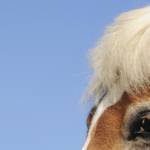Pemphigus Foliaceus Is a Serious Skin Disease in Horses

Pemphigus foliaceus is an autoimmune disorder in which an affected horse begins to manufacture antibodies against its own skin. As these antibodies attack the bonds that hold skin cells together, hair loss and hives develop, usually beginning on the face, legs, or abdomen and eventually spreading into other areas. As the disease progresses, the horse can develop swelling in the lower abdomen and legs. In some cases, blisters and pustules form and the horse can become covered with oozing, crusted areas of raw tissue.
The cause of pemphigus foliaceus is unknown, though there is some evidence that attacks may be related to insect bite hypersensitivity. Reactions to medications, vaccines, dewormers, and dietary supplements may play a role. Horses seem to be more susceptible during warmer weather, so exposure to ultraviolet light or allergens (pollen, dust) have also been blamed. Breed, age, and sex have not been tied to the condition, and a genetic link has not been proved in horses, though there is some evidence for a genetic cause in other species.
As with many diseases, early treatment leads to better results, but diagnosis of pemphigus foliaceus may not be easy in its earliest stages when clinical signs may point to other conditions such as ringworm, rain rot, insect bite reactions, or skin cancer. Skin biopsy and analysis of oozing skin fluid can aid in a correct diagnosis. Treatment is aimed at keeping the horse comfortable, supporting the growth of healthy skin, and reducing inflammation. Veterinarians may prescribe corticosteroids, vitamin E supplementation, and protection of the skin from insects and excessive sunlight.
Pemphigus foliaceus often requires long-term treatment, and some horses need medication throughout their lives. Young horses seem to have cases that are less severe and also respond better to treatment than older animals. About half of the horses that initially respond to treatment have recurrences within a year or two and subsequent treatments become less effective.
With no known cause, the disease can’t be prevented by vaccination or changes in management. Early treatment is the best idea, so owners should ask a veterinarian to examine horses that develop signs of skin disease or inflammation.








